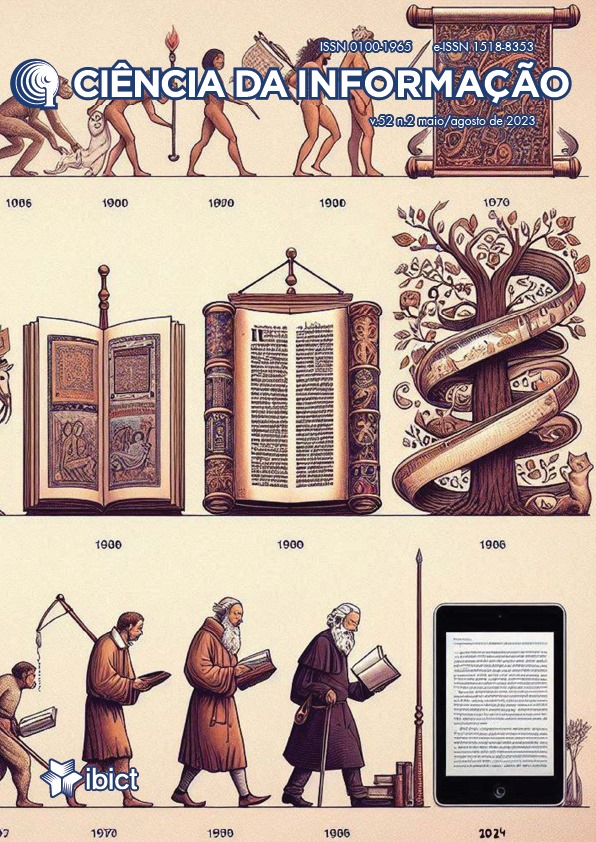Aceitação de tecnologias E-Health
um estudo de meta-análise
DOI:
https://doi.org/10.18225/ci.inf.v52i2.5963Palavras-chave:
healthcare 4.0, smart health, internet of health things, aceitação tecnológica, tecnologia da informaçãoResumo
Apesar do potencial benefício da utilização dos sistemas e-health para o compartilhamento de informações de saúde, a relação entre a tecnologia e seus fornecedores com potenciais usuários tende a ser complexa. Assim, torna-se importante interpretar os fatores que explicam a aceitação de novas tecnologias por parte dos potenciais usuários. Este trabalho tem por objetivo sintetizar os resultados de aceitação de tecnologias e-health. Para tanto utilizou-se relações e os constructos propostos no modelo UTAUT de aceitação de tecnologia. Ademais, testou-se os efeitos das variáveis moderadoras (gênero, faixa etária, presença de enfermidade, usuários, aplicação tecnológica e ano de publicação) nas relações propostas no UTAUT por meio do procedimento denominado meta-regressão. Verifica-se significância no efeito dos constructos “Expectativa de Desempenho”, “Expectativa de Esforço” e “Influência Social” no constructo “Intenção Comportamental”. Também é possível observar a significância do efeito dos constructos Intenção Comportamental e “Condições Facilitadoras” no constructo “Comportamento de Uso”. Dentre as variáveis moderadoras, somente a variável “faixa etária” não resultou moderação significativa para nenhuma relação. O presente estudo apresenta estimativas dos fatores que determinam a aceitação de novas tecnologias para saúde e sugere uma orientação geral para o desenvolvimento de novas tecnologias e-health considerando sua aceitação por parte dos usuários.
Downloads
Referências
Influencing the Adoption of Smart Wearable Devices. International Journal of Human–Computer Interaction, vol. 34, no. 5, p. 399–409, May 2018. https://doi.org/10.1080/10447318.2017.1357902.
AL-KHAFAJIY, Mohammed; THAR BAKER, ·; CHALMERS, · Carl; ASIM, · Muhammad; KOLIVAND, · Hoshang; FAHIM, · Muhammad; WARAICH, Atif. Remote health monitoring of elderly through wearable sensors. Multimedia Tools and Applications, vol. 78, p. 24681–24706, 2019. https://doi.org/10.1007/s11042-018-7134-7.
ALSSWEY, Ahmed; AL-SAMARRAIE, Hosam. Elderly users’ acceptance of mHealth user interface (UI) design-based culture: the moderator role of age. Journal on Multimodal User Interfaces, vol. 14, no. 1, p. 49–59, Mar. 2020. https://doi.org/10.1007/s12193-019-00307-w.
AN, J.-Y. Theory development in health care informatics: Information and communication technology acceptance model (ICTAM) improves the explanatory and predictive power of technology acceptance models. Studies in Health Technology and Informatics, vol. 122, p. 63–67, 2006. Available at: https://www.scopus.com/inward/record.uri?eid=2-s2.0-39049191130&partnerID=40&md5=660d46f738142e34585767358c50dfb5.
ATASEVEN, Cigdem; NAIR, Anand. Assessment of supply chain integration and performance relationships: A meta-analytic investigation of the literature. International Journal of Production Economics, vol. 185, p. 252–265, Mar. 2017. https://doi.org/10.1016/j.ijpe.2017.01.007.
BABA, N M; BAHARUDIN, A S; ALOMARI, A S. Determinants of users’ intention to use smartwatch. Journal of Theoretical and Applied Information Technology, vol. 97, no. 18, p. 4738–4750, 2019. Available at: https://www.scopus.com/inward/record.uri?eid=2-s2.0-85075540758&partnerID=40&md5=08eda88454b587327c8e8bec2afa2a2b.
BANNA, Sumayya; OTTESEN, Andri. Health solutions in developing countries: Case of Kuwait. Jun. 2018. 2018 IEEE International Conference on Innovative Research and Development, ICIRD 2018 [...]. [S. l.]: Institute of Electrical and Electronics Engineers Inc., Jun. 2018. p. 1–6. https://doi.org/10.1109/ICIRD.2018.8376316.
BEH, Phaik Khee; GANESAN, Yuvaraj; IRANMANESH, Mohammad; FOROUGHI, Behzad. Using smartwatches for fitness and health monitoring: the UTAUT2 combined with threat appraisal as moderators. Behaviour & Information Technology, , p. 1–18, Nov. 2019. https://doi.org/10.1080/0144929X.2019.1685597.
BHATTACHERJEE, Anol; HIKMET, Neset. Reconceptualizing organizational support and its effect on information technology usage: Evidence from the health care sector. Journal of Computer Information Systems, vol. 48, no. 4, p. 69–76, Jun. 2008. DOI 10.1080/08874417.2008.11646036. Available at: https://www.tandfonline.com/action/journalInformation?journalCode=ucis20. Accessed on: 15 Nov. 2021.
BORENSTEIN, M., HEDGES, L. V., HIGGINS, J. P., & ROTHSTEIN, H. R. Introduction to Meta-Analysis. [S. l.: s. n.], 2011.
BREWSTER, Liz; MOUNTAIN, Gail; WESSELS, Bridgette; KELLY, Ciara; HAWLEY, Mark. Factors affecting front line staff acceptance of telehealth technologies: a mixed-method systematic review. Journal of Advanced Nursing, vol. 70, no. 1, p. 21–33, Jan. 2014. https://doi.org/10.1111/jan.12196.
BUDRIONIS, Andrius; BELLIKA, Johan Gustav. The Learning Healthcare System: Where are we now? A systematic review. Journal of Biomedical Informatics, vol. 64, p. 87–92, 1 Dec. 2016. https://doi.org/10.1016/j.jbi.2016.09.018.
CANHOTO, Ana Isabel; ARP, Sabrina. Exploring the factors that support adoption and sustained use of health and fitness wearables. Journal of Marketing Management, vol. 33, no. 1–2, p. 32–60, Jan. 2017. https://doi.org/10.1080/0267257X.2016.1234505.
CARD, Noel A. Applied Meta-Analysis for Social Science Research. [S. l.: s. n.], 2015.
CAVALCANTE, R. B.; PINHEIRO, M. M. K.; WATANABE, Y. J. Á.; SILVA, C. J. D. Grupo técnico de informação em saúde e populações: contribuições para a política nacional de informação e informática em saúde. Perspectivas em Ciência da Informação, vol. 20, no. 1, p. 92–119, 2015. .
CHAU, Ka Yin; LAM, Michael Huen Sum; CHEUNG, Man Lai; TSO, Ejoe Kar Ho; FLINT, Stuart W.; BROOM, David R.; TSE, Gary; LEE, Ka Yiu. Smart technology for healthcare: Exploring the antecedents of adoption intention of healthcare wearable technology. Health Psychology Research, vol. 7, no. 1, p. 80–99, Mar. 2019. https://doi.org/10.4081/hpr.2019.8099.
CHAUHAN, S; JAISWAL, M. A meta-analysis of e-health applications acceptance: Moderating impact of user types and e-health application types. Journal of Enterprise Information Management, vol. 30, no. 2, p. 295–319, 2017. DOI 10.1108/JEIM-08-2015-0078. Available at: https://www.scopus.com/inward/record.uri?eid=2-s2.0-85014037761&doi=10.1108%2FJEIM-08-2015-0078&partnerID=40&md5=b5c6248f4bd66e4ea1975cf644ccb4c5.
CHEN, Ke; CHAN, Alan Hoi Shou. Gerontechnology acceptance by elderly Hong Kong Chinese: a senior technology acceptance model (STAM). Ergonomics, vol. 57, no. 5, p. 635–652, May 2014. https://doi.org/10.1080/00140139.2014.895855.
CIMPERMAN, Miha; MAKOVEC BRENČIČ, Maja; TRKMAN, Peter. Analyzing older users’ home telehealth services acceptance behavior-applying an Extended UTAUT model. International Journal of Medical Informatics, vol. 90, p. 22–31, Jun. 2016. https://doi.org/10.1016/j.ijmedinf.2016.03.002.
DA COSTA, Cristiano André; PASLUOSTA, Cristian F.; ESKOFIER, Björn; DA SILVA, Denise Bandeira; DA ROSA RIGHI, Rodrigo. Internet of Health Things: Toward intelligent vital signs monitoring in hospital wards. Artificial Intelligence in Medicine, vol. 89, p. 61–69, Jul. 2018. https://doi.org/10.1016/j.artmed.2018.05.005.
DAI, B; LARNYO, E; TETTEH, E A; ABOAGYE, A K; MUSAH, A.-A.I. Factors Affecting Caregivers’ Acceptance of the Use of Wearable Devices by Patients With Dementia: An Extension of the Unified Theory of Acceptance and Use of Technology Model. American Journal of Alzheimer’s Disease and other Dementias, 2019. DOI 10.1177/1533317519883493. Available at: https://www.scopus.com/inward/record.uri?eid=2-s2.0-85074693399&doi=10.1177%2F1533317519883493&partnerID=40&md5=c5c2056b537b5139942da30fd45d4576.
DAVIS, Fred D.; BAGOZZI, Richard; WARSHAW, P. User acceptance of computer technology: a comparison of two theoretical models. Management science, vol. 5, no. 8, p. 982–1003, 1989. .
DEBAUCHE, Olivier; MAHMOUDI, Saïd; MANNEBACK, Pierre; ASSILA, Abdessamad. Fog iot for health: A new architecture for patients and elderly monitoring. 160., 2019. Procedia Computer Science [...]. [S. l.]: Elsevier B.V., 2019. vol. 160, p. 289–297. https://doi.org/10.1016/j.procs.2019.11.087.
DROSATOS, George; KALDOUDI, Eleni. Blockchain Applications in the Biomedical Domain: A Scoping Review. Computational and Structural Biotechnology Journal, vol. 17, p. 229–240, 1 Jan. 2019. https://doi.org/10.1016/j.csbj.2019.01.010.
DUTTA, Bireswar; PENG, Mei Hui; SUN, Shu Lung. Modeling the adoption of personal health record (PHR) among individual: the effect of health-care technology self-efficacy and gender concern. Libyan Journal of Medicine, vol. 13, no. 1, Jan. 2018. https://doi.org/10.1080/19932820.2018.1500349.
ENAIZAN, O; ZAIDAN, A A; ALWI, N H M; ZAIDAN, B B; ALSALEM, M A; ALBAHRI, O S; ALBAHRI, A S. Electronic medical record systems: decision support examination framework for individual, security and privacy concerns using multi-perspective analysis. Health and Technology, vol. 10, no. 3, p. 795–822, 2020. DOI 10.1007/s12553-018-0278-7. Available at: https://www.scopus.com/inward/record.uri?eid=2-s2.0-85081328173&doi=10.1007%2Fs12553-018-0278-7&partnerID=40&md5=be0791658e15edec3e5aeff62287797d.
EVERETT, Rogers. Diffusion of innovations. New York, NY, USA,12: [s. n.], 1995.
FETTERMANN, Diego Castro; CAVALCANTE, Caroline Gobbo Sá; AYALA, Néstor Fabián; AVALONE, Marianne Costa. Configuration of a smart meter for Brazilian customers. Energy Policy, vol. 139, p. 111309, Apr. 2020. https://doi.org/10.1016/j.enpol.2020.111309.
GUO, Xitong; ZHANG, Xiaofei; SUN, Yongqiang. The privacy-personalization paradox in mHealth services acceptance of different age groups. Electronic Commerce Research and Applications, vol. 16, p. 55–65, Mar. 2016. https://doi.org/10.1016/j.elerap.2015.11.001.
HENNEMANN, Severin; BEUTEL, Manfred E.; ZWERENZ, Rüdiger. Drivers and barriers to acceptance of web-based aftercare of patients in inpatient routine care: A cross-sectional survey. Journal of Medical Internet Research, vol. 18, no. 12, p. e337, Dec. 2016. https://doi.org/10.2196/jmir.6003.
HOQUE, M. Rakibul; BAO, Yukun; SORWAR, Golam. Investigating factors influencing the adoption of e-Health in developing countries: A patient’s perspective. Informatics for Health and Social Care, vol. 42, no. 1, p. 1–17, Jan. 2017. https://doi.org/10.3109/17538157.2015.1075541.
HUNTER, John E.; SCHMIDT, Frank L. . Methods of meta-analysis: Correcting error and bias in research findings. [S. l.: s. n.], 2004.
IFINEDO, Princely. Applying uses and gratifications theory and social influence processes to understand students’ pervasive adoption of social networking sites: Perspectives from the Americas. International Journal of Information Management, vol. 36, no. 2, p. 192–206, Apr. 2016. https://doi.org/10.1016/j.ijinfomgt.2015.11.007.
JANG, Woo-Jung; JANG, Woojung. A Study on Current Status and Prospects of Global Food-tech Industry. Journal of the Korea Convergence Society, vol. 11, no. 4, p. 247–254, 2020. https://doi.org/10.15207/JKCS.2020.11.4.247.
JAYASEELAN, R; KOOTHOOR, Prasanth; PICHANDY, C. Index Terms ICT, E-Health, UTAUT, Health Communication, Health Management, Medical Doctors. Medical Doctors Article in International Journal of Scientific & Technology Research, vol. 9, 2020. Available at: www.ijstr.org. Accessed on: 15 Jun. 2021.
KAMAL, Syeda Ayesha; SHAFIQ, Muhammad; KAKRIA, Priyanka. Investigating acceptance of telemedicine services through an extended technology acceptance model (TAM). Technology in Society, vol. 60, p. 101212, 1 Feb. 2020. https://doi.org/10.1016/j.techsoc.2019.101212.
KAO, Y.-S.; NAWATA, K; HUANG, C.-Y. An exploration and confirmation of the factors influencing adoption of IoT-basedwearable fitness trackers. International Journal of Environmental Research and Public Health, vol. 16, no. 18, 2019. DOI 10.3390/ijerph16183227. Available at: https://www.scopus.com/inward/record.uri?eid=2-s2.0-85071764522&doi=10.3390%2Fijerph16183227&partnerID=40&md5=aedcdb0d6a2b69bc975703aa5e50ba2b.
KARPOVA, Elena V.; KARYAKINA, Elena E.; KARYAKIN, Arkady A. Wearable non-invasive monitors of diabetes and hypoxia through continuous analysis of sweat. Talanta, vol. 215, p. 120922, Aug. 2020. https://doi.org/10.1016/j.talanta.2020.120922.
KEMP, Andrew; PALMER, Edward; STRELAN, Peter. A taxonomy of factors affecting attitudes towards educational technologies for use with technology acceptance models. British Journal of Educational Technology, vol. 50, no. 5, p. 2394–2413, Sep. 2019. https://doi.org/10.1111/bjet.12833.
KHALIFA, J Itta Journal Of Information Technology Theory And Application; LIU, V. The State of Research on Information System Satisfaction. [S. l.: s. n.], 2004.
KHAN, Imran; XITONG, Guo; AHMAD, Zeeshan; SHAHZAD, Fakhar. Investigating Factors Impelling the Adoption of e-Health: A Perspective of African Expats in China. SAGE Open, vol. 9, no. 3, p. 1–12, Jul. 2019. https://doi.org/10.1177/2158244019865803.
KIJSANAYOTIN, Boonchai; PANNARUNOTHAI, Supasit; SPEEDIE, Stuart M. Factors influencing health information technology adoption in Thailand’s community health centers: Applying the UTAUT model. International Journal of Medical Informatics, vol. 78, no. 6, p. 404–416, Jun. 2009. https://doi.org/10.1016/j.ijmedinf.2008.12.005.
KOCH, Sabine. Home telehealth-Current state and future trends. International Journal of Medical Informatics, vol. 75, no. 8, p. 565–576, Aug. 2006. https://doi.org/10.1016/j.ijmedinf.2005.09.002.
LACERDA, Flavia; LIMA-MARQUES., Mamede. Da necessidade de princípios de Arquitetura da Informação para a Internet das Coisas. Perspectivas em Ciência da Informação, vol. 20, no. 2, p. 158–171, 2015. .
LAPÃO, Luís Velez. Artificial intelligence: is it a friend or foe of physicians? Einstein (São Paulo), vol. 17, no. 2, 2019. https://doi.org/10.31744/einstein_journal/2019ED4982.
LI, J; MA, Q; CHAN, A H; MAN, S S. Health monitoring through wearable technologies for older adults: Smart wearables acceptance model. Applied Ergonomics, vol. 75, p. 162–169, 2019. DOI 10.1016/j.apergo.2018.10.006. Available at: https://www.scopus.com/inward/record.uri?eid=2-s2.0-85055573600&doi=10.1016%2Fj.apergo.2018.10.006&partnerID=40&md5=1044438afc955b49b48e2996788918bb.
LIM, Sherwin; XUE, Lishan; YEN, Ching Chiuan; CHANG, Leanne; CHAN, Hock Chuan; TAI, Bee Choo; DUH, Henry Been Lirn; CHOOLANI, Mahesh. A study on Singaporean women’s acceptance of using mobile phones to seek health information. International Journal of Medical Informatics, vol. 80, no. 12, p. e189–e202, Dec. 2011. https://doi.org/10.1016/j.ijmedinf.2011.08.007.
LIN, Shu Ping; HSIEH, C. Y.; HO, Thao Minh. Innovative Healthcare Cloud Service Model | Scientific.Net. Applied Mechanics and Materials, vol. 543–547, p. 4511–4513, 2014a. .
LIN, Shu Ping; HSIEH, Chia Yen; HO, Thao Minh. Innovative healthcare cloud service model. 543–547., 2014b. Applied Mechanics and Materials [...]. [S. l.]: Trans Tech Publications, 2014. vol. 543–547, p. 4511–4513. https://doi.org/10.4028/www.scientific.net/AMM.543-547.4511.
LIU, Ivan; NI, Shiguang; PENG, Kaiping. Happiness at Your Fingertips: Assessing Mental Health with Smartphone Photoplethysmogram-Based Heart Rate Variability Analysis. Telemedicine and e-Health, , p. 1–9, Feb. 2020. https://doi.org/10.1089/tmj.2019.0283.
LOPES, I. L. Novos paradigmas para avaliação da qualidade da informação em saúde recuperada na Web. Ciência da Informação, v. 33, p. 81-90, 2004.
MACDONALD, Emma M.; PERRIN, Byron M.; HYETT, Nerida; KINGSLEY, Michael I.C. Factors influencing behavioural intention to use a smart shoe insole in regionally based adults with diabetes: A mixed methods study. Journal of Foot and Ankle Research, vol. 12, no. 1, p. 1–9, May 2019. https://doi.org/10.1186/s13047-019-0340-3.
MARINO, Maria Michela; RIENZO, Monica; SERRA, Nicola; MARINO, Nicola; RICCIOTTI, Raffaella; MAZZARIELLO, Luigi; LEONETTI, Concetta Anna; CERALDI, Maria Palma; CASAMASSIMI, Amelia; CAPOCELLI, Francesca; MARTONE, Gennaro; CARACCIOLO, Aniello Leonardo. Mobile Screening Units for the Early Detection of Breast Cancer and Cardiovascular Disease: A Pilot Telemedicine Study in Southern Italy. Telemedicine and e-Health, vol. 26, no. 3, p. 286–293, Mar. 2020. https://doi.org/10.1089/tmj.2018.0328.
MARITSCH, Martin; FÖLL, Simon; LEHMANN, Vera; BÉRUBÉ, Caterina; KRAUS, Mathias; FEUERRIEGEL, Stefan; KOWATSCH, Tobias; ZÜGER, Thomas; STETTLER, Christoph; FLEISCH, Elgar; WORTMANN, Felix. Towards Wearable-based Hypoglycemia Detection and Warning in Diabetes. Apr. 2020. Extended Abstracts of the 2020 CHI Conference on Human Factors in Computing Systems [...]. New York, NY, USA: Association for Computing Machinery (ACM), Apr. 2020. p. 1–8. https://doi.org/10.1145/3334480.3382808.
MARTINS, A Q; PERES, A M; DYNIEWICZ, A M; TONIOLO, R M; GONÇALVES, L S; NETO, P P. Integração da informação na Rede de Urgência e Emergência: percepção dos profissionais sobre o E-Saúde. Ciência da Informação, vol. 49, no. 1, 2020. .
MARTINS, T. G. S.; COSTA, A. L. F. A.; MARTINS, T. G. S. Big Data use in medical research. Einstein (Sao Paulo, Brazil), vol. 16, no. 3, p. 1–2, Sep. 2018. https://doi.org/10.1590/S1679-45082018ED4087.
MARTINS, A. Q.; PERES, A. M., DYNIEWICZ, A. M., TONIOLO, R. M., GONÇALVES, L. S., & NETO, P. P. Integração da informação na Rede de Urgência e Emergência: percepção dos profissionais sobre o E-Saúde. Ciência da Informação, v. 49, n. 1, 2020.
MATHIESON, Kieran. Predicting user intentions: Comparing the technology acceptance model with the theory of planned behavior. Information Systems Research, vol. 2, no. 3, p. 173–191, Sep. 1991. https://doi.org/10.1287/isre.2.3.173.
MENACHEMI, Nir; COLLUM, Taleah H. Benefits and drawbacks of electronic health record systems. Risk Management and Healthcare Policy, vol. 4, p. 47–55, 2011. https://doi.org/10.2147/RMHP.S12985.
MONTAGNI, Ilaria; TZOURIO, Christophe; COUSIN, Thierry; SAGARA, Joseph Amadomon; BADA-ALONZI, Jennifer; HORGAN, Aine. Mental Health-Related Digital Use by University Students: A Systematic Review. Telemedicine and e-Health, vol. 26, no. 2, p. 131–146, Feb. 2020. https://doi.org/10.1089/tmj.2018.0316.
MORESI, E. A. D.; LOPES, M.C.; DE MORAIS, M. A. A. T. O cidadão como sensor inteligente. Ciência da Informação, v. 45, n. 3, 2016.
NADLIFATIN, Reny; NADLIFATIN, Reny; MIRAJA, Bobby; PERSADA, Satria; BELGIAWAN, Prawira; REDI, A.A.N; LIN, Shu-Chiang. The Measurement of University Students’ Intention to Use Blended Learning... International Journal of Emerging Technologies in Learning (iJET), vol. 15, no. 9, p. 219–230, 2020. .
NAIR, Anand. Meta-analysis of the relationship between quality management practices and firm performance-implications for quality management theory development. Journal of Operations Management, vol. 24, no. 6, p. 948–975, Dec. 2006. https://doi.org/10.1016/j.jom.2005.11.005.
NAYAK, Laxman US; LEE, Priest; WHITE, Allan P. An application of the technology acceptance model to the level of Internet usage by older adults. Universal Access in the Information Society, vol. 9, no. 4, p. 367–374, 2010. .
NILSSON, Lina; HELLSTRÖM, Amanda; WENNERBERG, Camilla; EKSTEDT, Mirjam; EKSTEDT, Mirjam; EKSTEDT, Mirjam; SCHILDMEIJER, Kristina. Patients’ experiences of using an e-Health tool for self-management support after prostate cancer surgery: A deductive interview study explained through the FITT framework. BMJ Open, vol. 10, no. 6, p. e035024, Jun. 2020. https://doi.org/10.1136/bmjopen-2019-035024.
ONO, Hiroshi; ZAVODNY, Madeline. Gender and the Internet. Social Science Quarterly, vol. 84, no. 1, p. 111–121, Mar. 2003. https://doi.org/10.1111/1540-6237.t01-1-8401007.
OR, Calvin K.L.; KARSH, Ben Tzion; SEVERTSON, Dolores J.; BURKE, Laura J.; BROWN, Roger L.; BRENNAN, Patricia Flatley. Factors affecting home care patients’ acceptance of a web-based interactive self-management technology. Journal of the American Medical Informatics Association, vol. 18, no. 1, p. 51–59, Jan. 2011. https://doi.org/10.1136/jamia.2010.007336.
PAL, D.; FUNILKUL, S.; CHAROENKITKARN, N.; KANTHAMANON, P. Internet-of-Things and Smart Homes for Elderly Healthcare: An End User Perspective. IEEE Access, vol. 6, p. 10483–10496, 2018. https://doi.org/10.1109/ACCESS.2018.2808472.
PAL, Debajyoti; ARPNIKANONDT, Chonlameth; FUNILKUL, Suree; CHUTIMASKUL, Wichian. The Adoption Analysis of Voice Based Smart IoT Products. IEEE Internet of Things Journal, , p. 1–1, May 2020. https://doi.org/10.1109/jiot.2020.2991791.
PIOTROWICZ, Ewa. The management of patients with chronic heart failure: the growing role of e-Health. Expert Review of Medical Devices, vol. 14, no. 4, p. 271–277, 3 Apr. 2017. https://doi.org/10.1080/17434440.2017.1314181.
PITTALIS, Marios. Extending the technology acceptance model to evaluate teachers’ intention to use dynamic geometry software in geometry teaching. International Journal of Mathematical Education in Science and Technology, , p. 1–20, May 2020. https://doi.org/10.1080/0020739X.2020.1766139.
PIWEK, Lukasz; ELLIS, David A.; ANDREWS, Sally; JOINSON, Adam. The Rise of Consumer Health Wearables: Promises and Barriers. PLOS Medicine, vol. 13, no. 2, p. e1001953, Feb. 2016. https://doi.org/10.1371/journal.pmed.1001953.
RAZMAK, Jamil; BÉLANGER, Charles H.; FARHAN, Wejdan. Development of a techno-humanist model for e-health adoption of innovative technology. International Journal of Medical Informatics, vol. 120, p. 62–76, 1 Dec. 2018. https://doi.org/10.1016/j.ijmedinf.2018.09.022.
REEDER, Blaine; DAVID, Alexandria. Health at hand: A systematic review of smart watch uses for health and wellness. Journal of Biomedical Informatics, vol. 63, p. 269–276, Oct. 2016. https://doi.org/10.1016/j.jbi.2016.09.001.
SADOUGHI, Farahnaz; BEHMANESH, Ali; SAYFOURI, Nasrin. Internet of things in medicine: A systematic mapping study. Journal of Biomedical Informatics, 2020. https://doi.org/10.1016/j.jbi.2020.103383.
SAFI, S; DANZER, G; SCHMAILZL, K J G. Empirical research on acceptance of digital technologies in medicine among patients and healthy users: Questionnaire study. Journal of Medical Internet Research, vol. 21, no. 11, 2019. DOI 10.2196/13472. Available at: https://www.scopus.com/inward/record.uri?eid=2-s2.0-85076128742&doi=10.2196%2F13472&partnerID=40&md5=7af447c1ed2be1efbb3ac5f2dbc04e4f.
SALGADO, Tânia; TAVARES, Jorge; OLIVEIRA, Tiago. Drivers of Mobile Health Acceptance and Use From the Patient Perspective: Survey Study and Quantitative Model Development. JMIR mHealth and uHealth, vol. 8, no. 7, p. e17588, Jul. 2020. https://doi.org/10.2196/17588.
SCHMIDT, Frank L. History and development of the Schmidt-Hunter meta-analysis methods. Research Synthesis Methods, vol. 6, no. 3, p. 232–239, Sep. 2015. https://doi.org/10.1002/jrsm.1134.
SERGUEEVA, Ksenia; SHAW, Norman; LEE, Seung Hwan (Mark). Understanding the barriers and factors associated with consumer adoption of wearable technology devices in managing personal health. Canadian Journal of Administrative Sciences / Revue Canadienne des Sciences de l’Administration, vol. 37, no. 1, p. 45–60, Mar. 2020. https://doi.org/10.1002/cjas.1547.
SHARMA, Sushil K.; AHMED, Nazim; RATHINASAMY, Rathin S. E-healthcare: A model on the offshore healthcare delivery for cost saving. International Journal of Healthcare Technology and Management, vol. 6, no. 3, p. 331–351, 2005. https://doi.org/10.1504/IJHTM.2005.006540.
SHEMESH, Tomer; BARNOY, Sivia. Assessment of the Intention to Use Mobile Health Applications Using a Technology Acceptance Model in an Israeli Adult Population. Telemedicine and e-Health, , p. 1–9, Jan. 2020. https://doi.org/10.1089/tmj.2019.0144.
SUN, Sunny; LEE, Patrick C.; LAW, Rob; ZHONG, Lina. The impact of cultural values on the acceptance of hotel technology adoption from the perspective of hotel employees. Journal of Hospitality and Tourism Management, vol. 44, p. 61–69, Sep. 2020. https://doi.org/10.1016/j.jhtm.2020.04.012.
TALUKDER, Md Shamim; CHIONG, Raymond; BAO, Yukun; HAYAT MALIK, Babur. Acceptance and use predictors of fitness wearable technology and intention to recommend: An empirical study. Industrial Management and Data Systems, vol. 119, no. 1, p. 170–188, 4 Feb. 2019. https://doi.org/10.1108/IMDS-01-2018-0009.
TALUKDER, Md Shamim; SORWAR, Golam; BAO, Yukun; AHMED, Jashim Uddin; PALASH, Md Abu Saeed. Predicting antecedents of wearable healthcare technology acceptance by elderly: A combined SEM-Neural Network approach. Technological Forecasting and Social Change, vol. 150, p. 119793, Jan. 2020. https://doi.org/10.1016/j.techfore.2019.119793.
TAVARES, Jorge; OLIVEIRA, Tiago. Electronic Health Record Portal Adoption: A cross country analysis. BMC Medical Informatics and Decision Making, vol. 17, no. 1, p. 1–17, Jul. 2017. https://doi.org/10.1186/s12911-017-0482-9.
TSAI, Tsai-Hsuan; LIN, Wen-Yen; CHANG, Yung-Sheng; CHANG, Po-Cheng; LEE, Ming-Yih. Technology anxiety and resistance to change behavioral study of a wearable cardiac warming system using an extended TAM for older adults. PLOS ONE, vol. 15, no. 1, p. e0227270, Jan. 2020. https://doi.org/10.1371/journal.pone.0227270.
VAHDAT, Arash; ALIZADEH, Ali; QUACH, Sara; HAMELIN, Nicolas. Would you like to shop via mobile app technology? The technology acceptance model, social factors and purchase intention. Australasian Marketing Journal, Jan. 2020. https://doi.org/10.1016/j.ausmj.2020.01.002.
VÄISÄNEN, Jere; BUSINESS SCHOOL, Oulu; VÄISÄNEN JERE SUPERVISOR KOIVUMÄKI, Author T; TITLE, Lappi M. Oulu Business School Consumer Acceptance Of Future My Data Based Preventive Ehealth Services Consumer acceptance of future My Data based preventive eHealth services. [S. l.: s. n.], 2015.
VAN DER KAMP, Mattienne R; KLAVER, Emilie C; SPECTRUM, Medisch; BERNARD, Twente; THIO, J; JEAN, Twente; DRIESSEN, M M; TWENTE, Ziekenhuisgroep; TABAK, Monique; RESEARCH, Roessingh; VAN DER PALEN, Development Job. WEARCON: Wearable home monitoring in children with asthma reveals a strong association with hospital based assessment of asthma control. Research square, , p. 1–23, 2020. https://doi.org/10.21203/rs.3.rs-15928/v2.
VAN SLYKE, Craig;; CONCA, CHRISTOPHER; TRIMMER, Kenneth; 9 Requirements for SME Information Technology. Globalisation and SMEs in East Asia, vol. 1, p. 158, 2002. .
VENKATESH, Viswanath; BROWN, Susan A. A longitudinal investigation of personal computers in homes: Adoption determinants and emerging challenges. MIS Quarterly: Management Information Systems, vol. 25, no. 1, p. 71–98, 2001. https://doi.org/10.2307/3250959.
VENKATESH, Viswanath; MORRIS, Michael G. Why don’t men ever stop to ask for directions? Gender, social influence, and their role in technology acceptance and usage behavior. MIS Quarterly: Management Information Systems, vol. 24, no. 1, p. 115–136, 2000. https://doi.org/10.2307/3250981.
VENKATESH, Viswanath; MORRIS, Michael G.; DAVIS, Gordon B.; DAVIS, Fred D. User acceptance of information technology: Toward a unified view. MIS Quarterly: Management Information Systems, vol. 27, no. 3, p. 425–478, 2003. https://doi.org/10.2307/30036540.
VISHWAKARMA, Pankaj; MUKHERJEE, Srabanti; DATTA, Biplab. Impact of cashback usage restriction exemption on travel booking: a goal-directed approach. Tourism Recreation Research, vol. 45, no. 2, p. 218–230, Apr. 2020. https://doi.org/10.1080/02508281.2019.1683687.
WANG, Hailiang; TAO, Da; YU, Na; QU, Xingda. Understanding consumer acceptance of healthcare wearable devices: An integrated model of UTAUT and TTF. International Journal of Medical Informatics, vol. 139, p. 104156, 1 Jul. 2020. https://doi.org/10.1016/J.IJMEDINF.2020.104156.
WANG, X.; WHITE, L.; CHEN, X.; GAO, Y.; LI, H.; LUO, Y. An empirical study of wearable technology acceptance in healthcare. Industrial Management and Data Systems, vol. 115, no. 9, p. 1704–1723, Oct. 2015. https://doi.org/10.1108/IMDS-03-2015-0087.
WANG, Youfa; XUE, Hong; HUANG, Yaqi; HUANG, Lili; ZHANG, Dongsong. A Systematic Review of Application and Effectiveness of mHealth Interventions for Obesity and Diabetes Treatment and Self-Management. Advances in Nutrition: An International Review Journal, vol. 8, no. 3, p. 449–462, May 2017. https://doi.org/10.3945/an.116.014100.
WIEGARD, Rouven; GUHR, Nadine; KRYLOW, Sonja; BREITNER, Michael H. Analysis of wearable technologies’ usage for pay-as-you-live tariffs: recommendations for insurance companies. Zeitschrift fur die gesamte Versicherungswissenschaft, vol. 108, no. 1, p. 63–88, Feb. 2019. https://doi.org/10.1007/s12297-019-00431-2.
WU, Bing; CHEN, Xiaohui. Continuance intention to use MOOCs: Integrating the technology acceptance model (TAM) and task technology fit (TTF) model. Computers in Human Behavior, vol. 67, p. 221–232, Feb. 2017. https://doi.org/10.1016/j.chb.2016.10.028.
WU, Jing; LI, He; CHENG, Sherri; LIN, Zhangxi. The promising future of healthcare services: When big data analytics meets wearable technology. Information and Management, vol. 53, no. 8, p. 1020–1033, 1 Dec. 2016. https://doi.org/10.1016/j.im.2016.07.003.
XU, Lu; PENG, Xianghui; PAVUR, Robert; PRYBUTOK, Victor. Quality management theory development via meta-analysis. International Journal of Production Economics, vol. 229, p. 107759, 1 Nov. 2020. https://doi.org/10.1016/j.ijpe.2020.107759.
YARBROUGH, Amy K; SMITH, Todd B. Technology acceptance among physicians: a new take on TAM. Medical care research and review : MCRR, vol. 64, no. 6, p. 650–72, Dec. 2007. https://doi.org/10.1177/1077558707305942.
YEN, Po-Yin; MCALEARNEY, Ann Scheck; SIECK, Cynthia J; HEFNER, Jennifer L; HUERTA, Timothy R. Health Information Technology (HIT) Adaptation: Refocusing on the Journey to Successful HIT Implementation. JMIR medical informatics, vol. 5, no. 3, p. e28, Sep. 2017. https://doi.org/10.2196/medinform.7476.
ZHARKIKH, Elena V.; LOKTIONOVA, Yulia I.; KOZLOV, Igor O.; ZHEREBTSOVA, Angelina I.; SIDOROV, Victor V.; ZHEREBTSOV, Evgenii A.; DUNAEV, Andrey V.; RAFAILOV, Edik U. Wearable laser Doppler flowmetry for the analysis of microcirculatory changes during intravenous infusion in patients with diabetes mellitus. 11363., Apr. 2020. Tissue Optics and Photonics [...]. [S. l.]: SPIE, Apr. 2020. vol. 11363, p. 57. https://doi.org/10.1117/12.2552464.
ZOLAIT, A; RADHI, N; ALHOWAISHI, M M; SUNDRAM, V P K; ALDOSERI, L M. Can Bahraini patients accept e-health systems? International Journal of Health Care Quality Assurance, vol. 32, no. 4, p. 720–730, 2019. https://doi.org 10.1108/IJHCQA-05-2018-0106.
Downloads
Publicado
Edição
Seção
Licença
Copyright (c) 2024 Diego Fettermann, Luiz Philipi Calegari

Este trabalho está licenciado sob uma licença Creative Commons Attribution-ShareAlike 4.0 International License.
- A publicação se reserva o direito de efetuar, nos originais, alterações de ordem normativa, ortográfica e gramatical, com vistas a manter o padrão culto da língua, respeitando, porém, o estilo dos autores;
- As provas finais não serão enviadas aos autores;
- Os autores mantém os direitos totais sobre seus trabalhos publicados na revista Ciência da Informação, ficando sua reimpressão total ou parcial, depósito ou republicação sujeita à indicação de primeira publicação na revista, por meio da Licença Pública 4.0 Internacional Atribuição-CompartilharIgual
- Deve ser consignada a fonte de publicação original;
- As opiniões emitidas pelos autores dos artigos são de sua exclusiva responsabilidade;
- Cada autor receberá dois exemplares da revista, caso esteja disponível no formato impresso.





























